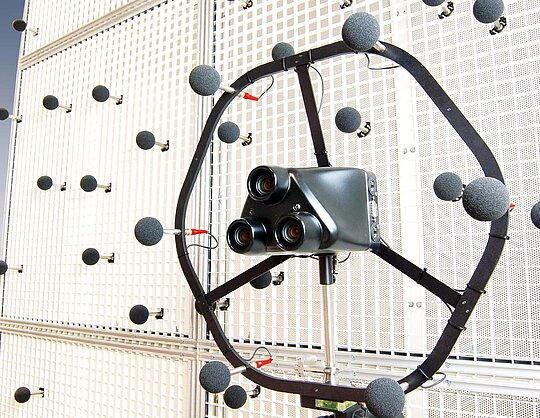HEAD VISOR Acoustic Cameras – Microphone arrays for localizing sound sources using beamforming technology
The HEAD VISOR acoustic camera measurement system comprises the software and a...
The HEAD VISOR acoustic camera measurement system comprises the software and a microphone array. The system uses beamforming technology to pinpoint sound sources in real-time. Various microphone arrays are available for different applications. Some are scalable and customizable; all can be activated and controlled with HEAD VISOR software.
When the microphone array is switched on, HEAD VISOR software provides video images with simultaneously overlaid, high-quality acoustic source mapping. This feature lets you quickly obtain the necessary information about the sound sources without delay - identify their location, sound pressure level, and spectrum.
All three hardware versions combine beamforming with MultipleEye technology, using multiple cameras to record the video images in real-time. This process enables distances to all points in the image to be determined with exceptional precision and allows continuous, synchronous video images in real time.
The following HEAD VISOR microphone arrays are available for the acoustic camera:
- HEAD VISOR VMA V: Lightweight, mobile, hand-held, and extendable microphone array with an integrated display and controls for the most flexible applications and results showing directly on the device (0.3 m/1.0 m diameter)
The HEAD VISOR acoustic camera measurement system comprises the software and a microphone array. The system uses beamforming technology to pinpoint sound sources in real-time. Various microphone arrays are available for different applications. Some are scalable and customizable; all can...
The HEAD VISOR acoustic camera measurement system comprises the software and a microphone array. The system uses beamforming technology to pinpoint sound sources in real-time. Various microphone arrays are available for different applications. Some are scalable and customizable; all can be activated and controlled with HEAD VISOR software.
When the microphone array is switched on, HEAD VISOR software provides video images with simultaneously overlaid, high-quality acoustic source mapping. This feature lets you quickly obtain the necessary information about the sound sources without delay - identify their location, sound pressure level, and spectrum.
All three hardware versions combine beamforming with MultipleEye technology, using multiple cameras to record the video images in real-time. This process enables distances to all points in the image to be determined with exceptional precision and allows continuous, synchronous video images in real time.
The following HEAD VISOR microphone arrays are available for the acoustic camera:
- HEAD VISOR VMA V: Lightweight, mobile, hand-held, and extendable microphone array with an integrated display and controls for the most flexible applications and results showing directly on the device (0.3 m/1.0 m diameter)
Highlights
- Acoustic camera with beamforming technology for localizing sound sources online
- Customizable, scalable system for diverse applications
- Interactive working is possible because changes are visualized in real-time without delay
- Raw data workflow, all parameters can also be adjusted after recording
- Convenient licensing options for any need, scalable software via tool packets
- Extremely high location accuracy
- MultipleEye technology: Continuous, synchronous video images in real-time and the ability to determine distances to all points in the image with exceptional precision
- Unique algorithms to increase spatial resolution and dynamics (e.g., neural deconvolution)
Applications
- Troubleshooting
- Analyzing and optimizing sounds
- Auralizing locations that radiate the most sound energy
- Test benches
- Detecting sound-radiating components on test pieces
- Room and structural acoustics
- Leak detection/testing
- Visualizing acoustic weak points
- Wind tunnels
- Wind turbines
- Analyzing the acoustic effects of different rotor designs
Features
- High-quality hardware components for HEAD VISOR beamforming systems
- VMA V: Mobile array with optional ten spiral arms (60+60 microphones), an integrated display, battery, depth camera, and front end (0.3 m/1.0 m diameter)
- All arrays are linked to a PC via a single network cable
- Additional sensors can be connected (integration of HEADlab products)
- Near-field HEAD VISOR Probe can be connected to microphone arrays to extend the lower frequency limit



